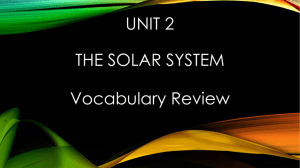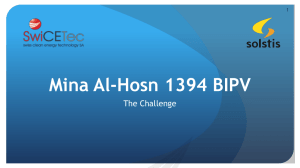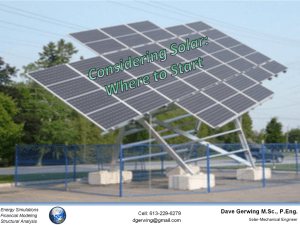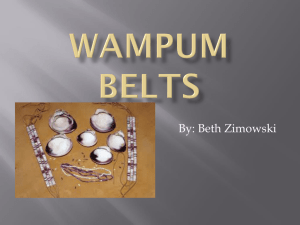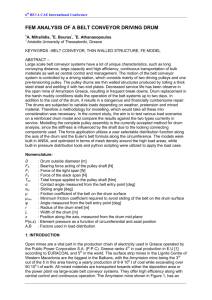Michael Jensen, ODFW - John Day Screen and Passage Program
advertisement
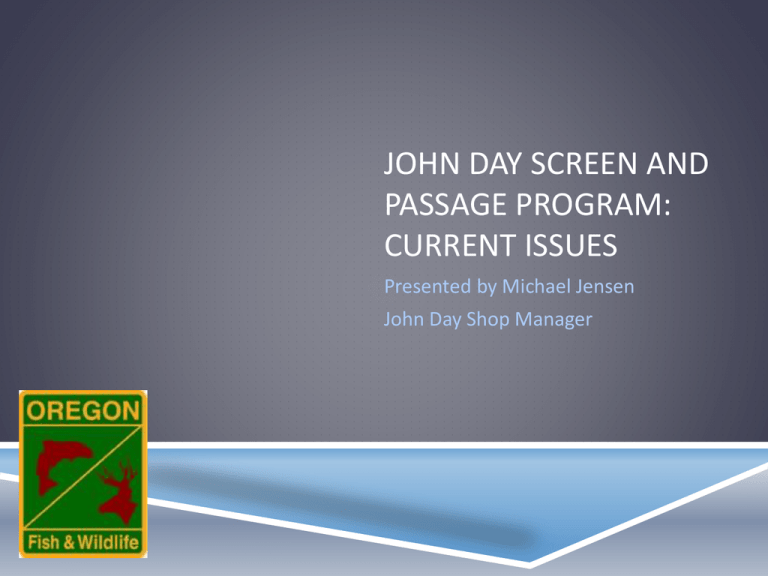
JOHN DAY SCREEN AND PASSAGE PROGRAM: CURRENT ISSUES Presented by Michael Jensen John Day Shop Manager PROGRAM OVERVIEW New Project Funding ODFW Cost Share BPA At least 20 projects per year Maintenance Fishing License Surcharge Mitchell Act (NOAA) Over 300 screen sites in Anadromous Over 45 passage structures in Anadromous Over 200 pump screen sites in Anadromous Over 60 screen, passage and pump screen sites in Non-Anadromous AREA OF RESPONSIBILITY PRESENTATION TOPICS Intralox/Hydrolox Drum Belt Screen Self – Adjusters Orifice Boards Solar Panels INTRALOX/HYDROLOX DRUM We have several sites that have excessive hard water West Branch Bridge Creek near Mitchell, Oregon – 4’x24” solar drum Originally installed in 2000 Rotary brush installed in 2010 for additional cleaning Hard water deposits were still occurring Hydrolox belt material installed as alternative to Stainless Steel Perforated Plate on June 5th, 2013 SCREEN AS OF 2010 THE PROBLEM! NEW SCREEN MATERIAL CONCLUSIONS Perforated Plate – 33% open area Last purchase of 4 foot wide SS Perforated plate was $37.52 per foot 80 inches used equals $250.13 Intralox / Hydrolox material – 32% open area On a 4 foot wide screen, this equals $116.14 per foot 93 inches used equals $900.08 Based on angle between modules and curvature of drum, would not recommend Intralox/Hydrolox material on anything smaller than an 18 inch diameter drum (seal issues) CURRENT STATUS As of August 19th, 2013: BELT SELF - ADJUSTERS Background In conjunction with the use of Intralox/Hydrolox belt material (on belt screens), John Day uses a solid steel roller on bottom Advantages: Reduces construction costs For a three foot belt: Cost of three foot roller ≈ $400, Cost of three foot Intralox shaft, sprockets, and collars ≈ $700 Reduces tracking issues Disadvantages (at least what we think): Material deposition between belt and roller The Problem As material builds up, only way for belt material to adjust is to break Solution Spring operated self-adjusters Testing One site converted from wiper to a series of belt screens in July 2013 ORIFICE BOARDS Background Water becomes more scarce as irrigation season progresses Most sites, water right is cut in half after June 1st in the John Day Basin The Problem Difficult to design a screen that can fit a wide range of irrigation flows Paddlewheel driven rotary drums have always been the initial consideration for all sites The current 16 blade paddlewheel is very safe (for employees), but will not operate under all water flow conditions Where a paddlewheel driven rotary drum won’t work, utilize solar Solar is more expensive One Solution Orifice Boards Can be made out of any size PVC pipe Cutting the pipe to a length where it ends near the paddlewheel blade is more important than the size of pipe SOLAR PANELS Background Use of solar at sites that have extreme ranges in water use Typically dictated by the low end of water use where a paddlewheel won’t work John Day design calls for 24 volt solar system In 2009, a 50 Watt, 12 volt Panel cost around $300 To conserve money, it was determined that two, 50 watt panels wired in series (voltage doubles to 24 volt) was the minimum on our screen projects With two 100 amp/hour batteries, and the two 50 watt panels, expected to last for three consecutive cloudy days Amperage output was around 2.5 amps for the combined array Total cost for both panels equaled $600 (complete solar unit between $2,000 and $2,500) Today, I could purchase a 230 Watt, 24 volt Panel for $175 Voltage is already at the amount we need for our systems Amperage output for this size of panel is almost 8 amps (over three times the output) Savings of $400



